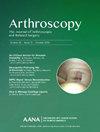髌骨软骨缺损的卸载需要量身定制的胫骨结节截骨手术。
IF 5.4
1区 医学
Q1 ORTHOPEDICS
Arthroscopy-The Journal of Arthroscopic and Related Surgery
Pub Date : 2024-10-18
DOI:10.1016/j.arthro.2024.10.012
引用次数: 0
摘要
在髌骨不稳的情况下,髌骨软骨缺损很常见。目前已有多种手术方法可解决伴随的软骨缺损问题,包括自体软骨细胞植入术(ACI)和骨软骨异体移植术(OCA),但对此类缺损的最佳治疗方法尚未达成共识。无论采用哪种技术处理软骨病变,通过胫骨结节截骨术(TTO)减轻缺损部位的负荷,以及通过髌股关节内侧韧带重建术(MPFL)稳定髌骨,都是髌股关节保留手术的重要组成部分。确定软骨缺损的具体位置可让我们在卸载病变部位和处理不稳定性时对 TTO 进行量身定制。通过精确定位矫正TTTG距离所需的结节内翻量、矫正AP-TTTG(或sTTTG)距离所需的前翻量,以及矫正髌骨高度所需的远翻量,我们已经能够改进处理膝关节冠状位和矢状位对齐的方法。通过提高根据每位患者的形态和特定损伤模式测量和比较缺陷的精确度,我们可以为每位患者量身定制手术方案,优化髌骨不稳情况下的软骨病理治疗。本文章由计算机程序翻译,如有差异,请以英文原文为准。
Editorial Commentary: Offloading Patellofemoral Chondral Defects Requires Tailored Tibial Tuberosity Osteotomy Procedures
The presence of patellofemoral chondral defects is common in the setting of patellar instability. Multiple procedures have been described to address concomitant chondral defects including autologous chondrocyte implantation (ACI) and osteochondral allograft (OCA) transplantation, with lack of consensus on the optimal management of such defects. Regardless of the technique used to address the cartilage lesion, offloading the defect with a tibial tuberosity osteotomy (TTO) and stabilizing the patella through medial patellofemoral ligament reconstruction are important components of patellofemoral joint preservation surgeries. Identifying the specific location of the chondral defect allows us to tailor the TTO when offloading the lesion and addressing instability. By specifying the precise amount of tuberosity medialization needed to correct the TTTG distance and the amount of anteriorization to correct the anterior-posterior TTTG (or sagittal TTTG) distance, combined with the amount of distalization needed to correct patellar height, we have been able to improve the way we address the coronal and sagittal alignment of the knee. By improving the precision with which we measure and compare defects based on each patient’s morphology and specific injury patterns, we can tailor procedures to each individual to optimize the management of chondral pathology in the setting of patellar instability.
求助全文
通过发布文献求助,成功后即可免费获取论文全文。
去求助
来源期刊
CiteScore
9.30
自引率
17.00%
发文量
555
审稿时长
58 days
期刊介绍:
Nowhere is minimally invasive surgery explained better than in Arthroscopy, the leading peer-reviewed journal in the field. Every issue enables you to put into perspective the usefulness of the various emerging arthroscopic techniques. The advantages and disadvantages of these methods -- along with their applications in various situations -- are discussed in relation to their efficiency, efficacy and cost benefit. As a special incentive, paid subscribers also receive access to the journal expanded website.

 求助内容:
求助内容: 应助结果提醒方式:
应助结果提醒方式:


